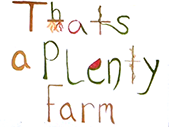In order to support pollinators, our habitat must have food for them throughout the season, from the very earliest possible bloom time to the end of the pollinator season. We also must provide location and sustenance for their young, as well as proper conditions for nesting, and also water and clay. Our primary target is native pollinators, especially those that will support the farms that surround us.
Here’s the list of plants in the pollinator nursery 2011 (*the wildflowers that will be in the one-acre meadow; **both nursery and meadow).
achillea millefolium, yarrow
achillea terracotta, yarrow
agastache foeniculum, lavender giant hyssop*
aquilegia canadensis, eastern columbine*
amsonia salicifolia, Eastern bluestar
asclepias tuberosa, butterfly milkweed**
aster novae-angliae, New England aster
aster woods light blue
aster woods pink
aster woods purple
baptisia australis, false blue indigo**
calylophus serrulatus, prairie lode
chamaecrista fasciculata, partridge pea*
chelone lyonii, pink turtlehead
cherianthus allionii, siberian wallflower*
coreopsis tinctoria, plain coreopsis*
cynoglossum amabile, chinese forget me not / hounds tongue*
echinacea purpurea, purple coneflower**
eryngium yuccifolium, rattlesnake mailer
eupatorium fistulosum, Joe Pye Weed
gaillardia pulchellea, annual gaillardia / fire wheel**
helenium flexuosum, purplehead sneezeweed
helianthus annus, sunflower**
helianthus helianthiodes, sunflower everlasting
heliopsis helianthoides, summer nights
liatris spicata, gayfeather / blazing star**
lobularia maritima, sweet alyssum
lupinus perennis, perennial lupine**
monarda citriodora, lemon mint*
monarda didyma, Jacob Cline
nepeta sibirica, souvenir
oenothera fruiticosa, fireworks
oligoneuron album, white upland aster*
papaver rhoeas, corn poppy*
penstemon digitalis, foxglove beardtongue
phacelia tenacetifolia
prunus
pycnanthemum incarnum, mountain mint
rubus, blackberry, raspberry
rudbeckia fulgida, eastern coneflower
rudbeckia hirta, black eyed susan**
rudbeckia submentosa, Henry Eilers
salix discolor, pussy willow
sambucus, elderberry
scabiosa, butterfly blue
sporobolus heterolepsis, prairie dropseed
stokesia laevis, aster peaches pink
symphyotrichum laeve, smooth aster*
tradescantia ohiensis, ohio spiderwort*
trifolium incarnatum, crimson clover**
trifolium repens, Dutch white clover
vaccinium angustifolia, low bush blueberry
and compost crops on the border of the meadow:
alfalfa
sunflowers (perennial and annual)
red clover or crimson clover
hairy vetch
We appreciate the guidance and assistance given us by:
Vincent Snyder, Director, Natural Resources Conservation Service, Hadley, MA
Tristram Seidler, PhD, New England Wildflower Society
Zach Mermel, Permaculture Landscape Designer
Tom Sullivan, Permaculture Pollinator Habitat Designer
Dan Kittredge, Director, Real Food Campaign
Hadley Garden Center
